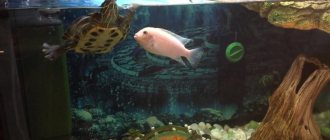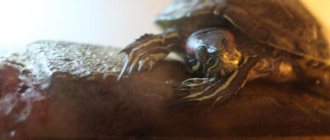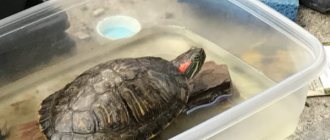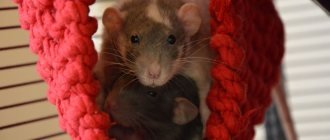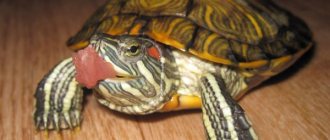The poor birth rate of this species of reptile is also explained by the incompetence of the owners regarding how red-eared turtles reproduce and the inability to create suitable conditions for this.
Determination of gender
To ensure reptiles reproduce at home, it is necessary to find out which sex each turtle belongs to. Obviously, the offspring is the result of the mating of a male and a female.
This is interesting: A female reptile can lay eggs without the participation of a male, but storing them will not give any results, since fertilization in this case was not carried out.
Sexual dimorphism in red-eared turtles appears at one year of age. For comparison, it is recommended to take reptiles of the same age. The distinction between individuals is carried out according to the following criteria:
- body size (females are larger);
- claws on the front paws (in males they are longer);
- tail (longer in males than in females);
- the shape of the lower part of the shell (in females it is flat, in boys it is concave).
Mating process in nature
First of all, it should be clarified that the genital organs of turtles are located in the tail. Therefore, the male approaches the chosen one from behind and crawls onto her back with the front part of his body. He adapts his tail under hers, directing the sexual organ to the right place.
At the end of the action, the male emits a “victory cry”. And let only his chosen one hear it, but this is the song of a winner who has achieved his goal. The female also responds to him with a “yelp.” This is how turtles mate in nature.
Conditions for mating
Reproduction of the red-eared turtle is possible subject to the optimal age for mating - individuals must be young, but at the same time have reached sexual maturity. The readiness of females to reproduce is observed at the age of five, males begin to give birth to offspring in the fifth year of life. If you keep more than two turtles at the same time, it is advisable that there is only one male among them, otherwise the males will fight for the opportunity to mate, causing injury to each other.
Pond slider
Where does the red-eared turtle live in its natural environment?
The red-eared freshwater turtle is a resident of North America. The Mississippi River is called its homeland - these animals can be seen there most often. It prefers a warm climate, so it is common in the southern states of the United States. But at the present stage, this animal has spread throughout the world. In some areas its presence causes problems for local fauna.
The conditions in which the red-eared freshwater turtle prefers to live are characterized by the following features:
- warm fresh water,
- the presence of dense vegetation,
- weak current,
- islands of land or shore where you can bask.
Such turtles live in lakes, swamps and ponds - it is these reservoirs that satisfy their needs. They prefer the water's edge, without moving long distances from the shore. An adult red-eared turtle lays its eggs in hard ground.
Preparation
Getting red-eared turtles to breed in captivity is quite a difficult task. To achieve the desired result, you first need to take care of your pets’ diet. Reptile food should include vitamins and nutrients. Vitamin E is especially useful for males, as it has a positive effect on the reproductive function of animals. Calcium and phosphorus are useful for the normal course of pregnancy in females.
Before the intended mating, two turtles need to be placed in different aquariums. To create a suitable environment, it is recommended to change the water and heat it to 25 ° C. It happens that during the mating process, the male does not allow the female to come to the surface for a long time. To prevent the reptile from suffocating, the water level in the aquarium should not exceed 10 centimeters. A container with sand must be placed inside the vessel, where the female will lay eggs.
It should be located in a dry area that is easily accessible to the turtle. Please note that mating will only occur if there is soil in the aquarium. A sign indicating that the female is ready to reproduce is the reptile displaying high activity, as well as its refusal to eat.
Brief description of the order of turtles
These animals belong to the order of reptiles. They live in captivity up to 50 years. But in the natural environment they can exist about twice as many. Although there are legends that there are individuals that have reached 350 years or more. But only the lifespan of the Madagascan radiant tortoise Tui Malila is documented - 188 years. Today she is considered a long-living winner.
A distinctive feature of all types of turtles is the presence of a shell. Perhaps, thanks to him, they managed to survive, despite various disasters that occurred on our planet. After all, these creatures are very ancient.
How do turtles mate?
Large and beautiful terrarium for turtles
Home maintenance does not imply that the breeding season depends on the changing seasons of the year, so reptiles can mate at any time. According to general observations, turtles are most active from February to May. Thus, the process of mating pets is best carried out at this time.
Until the moment of copulation, reptiles engage in mating games, which can last for several days in a row. During this period, the most important thing is to create the most comfortable conditions for the animals, ensuring them complete peace. Reptiles should not be disturbed by extraneous noise, vibration or bright light. Also, you should not pick up your pets during this time.
The process of mating games is that the male touches the female’s head with his claws and brings his shell into contact with the female’s plastron. The copulation time of reptiles is no more than five minutes. Then eggs are laid.
Mating games
Turtles are no strangers to demonstrative displays of affection. Males become very active during the mating season. Many people make the mistake of considering turtles to be silent creatures. After all, males, when courting their darlings, often make sounds similar to yapping. And females have the right to express their opinion with their voice.
Usually males challenge rivals to fights. And during the period of “fighting”, weak animals can be injured and die. So it would be a huge mistake to consider turtles as calm and good-natured animals.
The male is not so loyal to his chosen one either. Seeing a female, it begins to shake its head up and down. But he does not intend to wait for her to reciprocate her feelings. Having performed a ritual dance of recognition, the male runs to the turtle and hits it hard with his head in the shell. In addition, he bites the reptile's paws until it is eventually subdued.
Caring for eggs and young
In one clutch the female leaves from 6 to 10 eggs. The diameter of each is 4 cm. The container in which the masonry is located is emptied. The eggs are very carefully transferred to the incubator without turning them over. The temperature in it should be in the region of 25-30 oC. Instead of an incubator, you can use a regular jar of sand, which should be placed next to the heating system to create optimal temperature conditions.
The period of development of the young inside the egg is 2-5 months. All this time it is necessary to maintain the established temperature indicators. As soon as the turtles are born, place them in a separate aquarium where they will be kept for a year.
Temperature conditions for turtle breeding
For successful reproduction, turtles must be in a certain temperature range, namely +25-+30° C. Maintaining this temperature is extremely important for hormonal status, the formation and maturation of sperm. In our climate zone, it is impossible to obtain the desired temperature without artificial heating. For breeding purposes, it is especially important to maintain the desired temperature range in March, April and May, since the spring months are the main period in the breeding cycle.
Breeding problems
Any turtle breeder faces breeding problems. The most common mistakes are:
unfertilized eggs. In the absence of males, turtles lay “empty” eggs. Only after copulation does conception and successful laying occur;
failure to maintain humidity and correct air temperature in the terrarium;
the absence of mating games negatively affects the interest of males in young females. The partner must win the female, become the winner and receive the desired prize;
a poor diet and lack of vitamins also negatively affect the offspring.
Keeping turtles at home
There are actually three options for keeping turtles:
- Free, just walking around the apartment.
- In a terrarium.
- In specially equipped enclosures.
You should choose depending on what type of turtle you are going to purchase. That is, in other words, you should find out in the store when purchasing where this species lives in nature, what they like most.
Cleaning up after a turtle is actually even easier than cleaning up after a cat, which is why there will be no difficulties in maintaining and caring for it. You should feed her only in one specific place, and not just anywhere, she must get used to it. Over time, the animal will get used to it and will come to this place when it wants to eat.
When the heating in the apartment is turned off and it becomes cool, you need to put the turtle in some kind of box at night, it will be warmer. Many species of these animals, when they freeze, become lethargic and sick, and may even die.
When cleaning the aquarium, be sure to turn off the heater, otherwise it may break, then after cleaning it must be turned on again. In order to control the temperature, it is necessary to install special thermometers, or best of all, two. Mercury thermometers cannot be used, as they are very harmful.
Recommendations to the owner for reproduction
Turtles are animals that reproduce quite poorly in captivity. In order to successfully breed these unusual animals, you need to take some steps. So, what needs to be done to ensure that turtles reproduce at home.
Arrangement of the terrarium
Sufficient space is required for turtles to move freely. Therefore, the first thing you need to pay attention to is the area of the terrarium. Height is of secondary importance, but it should not exceed 45-50 cm.
Since turtles come in different sizes, the size of the terrarium should be appropriate. The recommended size is 5-6 times the size of the animal itself. Several sides of the terrarium and its top should be mesh for air access.
Glass and wood are preferred materials for the terrarium, but durable, non-toxic plastic can also be used.
Stimulation by light and heat
The most important condition for the reproduction of turtles is temperature. It is necessary to ensure an air temperature of +25 +30 °C. This is a must.
A heating lamp is used to ensure the required temperature. It needs to be installed in the corner of the terrarium at a distance of 30-35 cm from the ground surface.
For the health of turtles, in order to prevent rickets, an ultraviolet lamp is used in the terrarium. This light is especially necessary for pregnant turtles and young turtles. Turtles should have at least 10-12 hours of daylight. The UV lamp is turned off at night.
Caring for a female during pregnancy
Actions after turtles mate:
- We place the female and male in different terrariums (this is done so that the male does not harm the female).
- During pregnancy (turtles carry eggs for 2-3 months), you need to feed the female foods that are rich in vitamins, especially calcium.
- Set the temperature in the terrarium to +22 +26 °C.
Incubation period
After laying eggs, the mother's mission ends. The female turtle forgets about her children.
The turtle is isolated for several days. Over the course of 2-3 weeks, the female’s diet is strengthened and saturated with nutrients to restore strength. The eggs are transferred to the incubator.
- Pour a 20 cm thick layer of sand into the incubator.
- Set the temperature to 29 °C and maintain it throughout the incubation period.
- Place a container of water under the heating lamp.
During incubation, turning or moving eggs is prohibited.
After 90 days, offspring will begin to emerge from the eggs.
Stimulation of turtle reproduction
Temporarily separating males and females is a technique used by experienced breeders. It consists in the fact that males are separated from females for several weeks, and then, when they are introduced to them again, the males’ interest in the opposite sex increases significantly.
For breeding land turtles, it is recommended to have at least two males per female. Since in nature males fight for the opportunity to mate with the opposite sex, it is possible to allow them to be aggressive towards each other. If there is no competitor, the male may lose interest in the female. However, in species such as the Balkan tortoise (Testudo hermmanni), the fringed tortoise (Testudo marginata), and the Turkish Mediterranean tortoise (Testudo ibera), aggression must be carefully controlled, otherwise the males of these species can cause serious injury to each other.
It is believed that one of the factors stimulating reproduction is hibernation. But it must be remembered that not all types of turtles can be hibernated. You should also properly organize the turtle's hibernation, otherwise the animal may die.
The next condition is to provide the female with a suitable place. where she can lay her eggs. Read the following article to learn how to properly arrange a place for a turtle’s nest.
Pregnancy and childbirth
After successful fertilization, it is important to take care of the conditions for laying eggs and their contents:
- Purchase a vessel with filler for future masonry. Use sphagnum moss, vermiculite or sand.
- Prepare an incubator with a temperature of 28-30 degrees and 80% humidity to keep small reptiles for the next 2-3 months.
- Enrich the expectant mother's diet with protein foods and vitamins, and also increase the usual amount of food by 2-3 times.
A change in the female’s behavior will tell you about an imminent birth:
- signs of anxiety;
- attempts to dig holes in the ground;
- increased time spent on land;
- refusal to eat.



